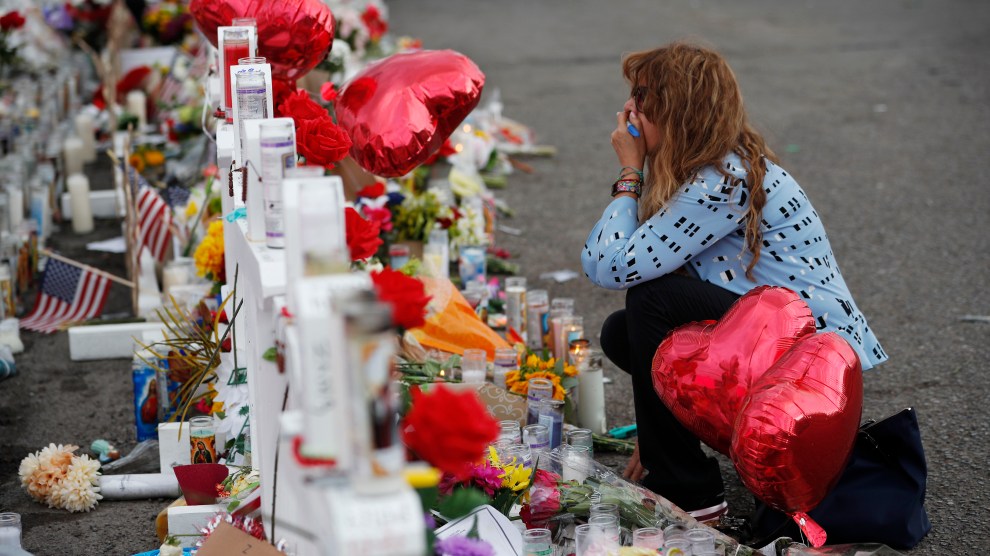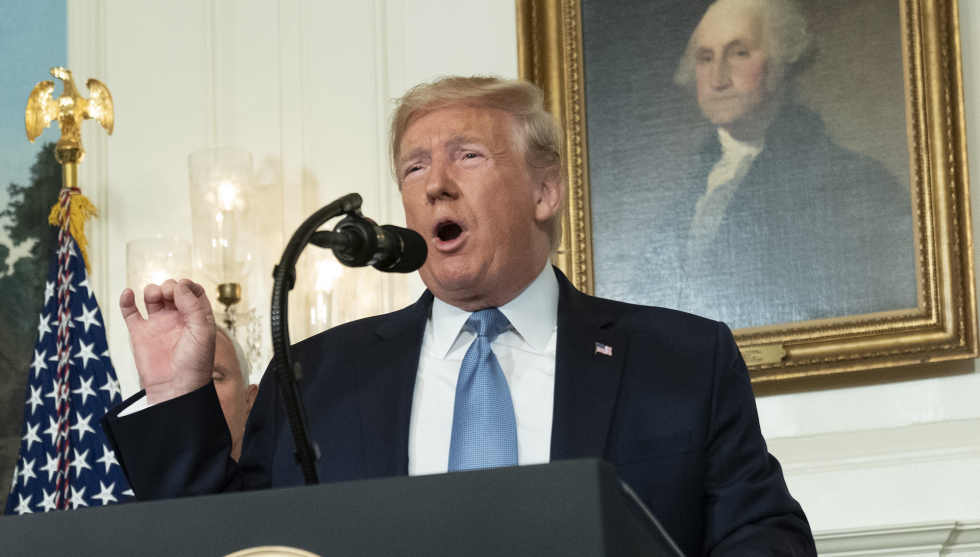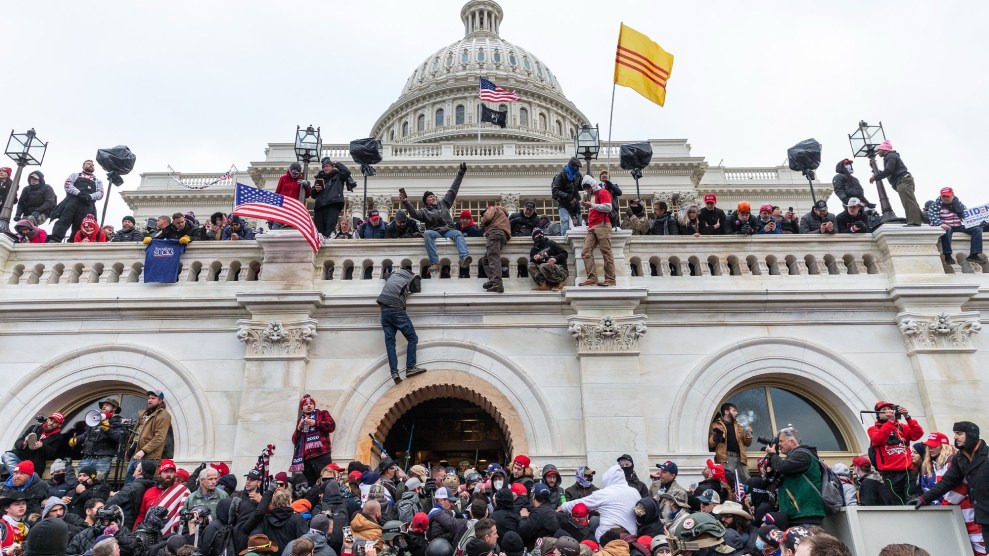
Gloria Garces kneels in front of crosses at a makeshift memorial near the scene of a mass shooting at a shopping complex Tuesday, Aug. 6, 2019, in El Paso, Texas. John Locher/AP
A little more than a week before a shooter intent on attacking “as many Mexicans as possible” killed 22 people and wounded dozens in El Paso, Texas, FBI Director Christopher Wray told the Senate that most domestic terrorist arrests in 2019 have involved some form of white supremacy. He noted that such acts of violence are on the rise, and in an effort to assure lawmakers that the FBI is properly pursuing far-right extremists, Wray said, “Needless to say, we take domestic terrorism or hate crime, regardless of ideology, extremely seriously.”
But the federal government has come under fire in recent years for not doing more to prosecute and protect against the mounting threat of racist violence. Under Trump, the Department of Homeland Security has tried to redirect resources from combating far-right, anti-government, and white supremacist groups in favor of targeting Central American migrants and refugees. Trump’s DHS has awarded at least 85 percent of its Countering Violent Extremism grants to programs targeting Muslims, Black Lives Matter activists, LGBTQ Americans, immigrants, and refugees, according to the Brennan Center for Justice, a nonpartisan policy institute at the New York University School of Law.
Two of the three recent mass shootings—El Paso, Texas, and Gilroy, California, but not Dayton, Ohio—will now be treated as domestic terrorism cases. This is an unusual step, and the decision sparked some confusion about why the government hasn’t done more to this point to combat far-right violence. Is it because there are no federal penalties for domestic terrorism, as the New York Times reported? Or is it a matter of departmental prerogative that could be quickly reversed if the attorney general simply chose to do so? What might be accomplished through legislation like Illinois Sen. Dick Durbin’s bill, which would require federal law enforcement to make joint annual reports to Congress that “assess the domestic terrorism threat posed by white supremacists”?
Michael German, a national security fellow at the Brennan Center and author of the forthcoming book Disrupt, Discredit, and Divide: How the New FBI Damages Democracy, has answers to these questions. A former FBI special agent who was tasked with infiltrating extremist groups, German left the bureau in part because of a failed domestic terrorism investigation. In 2002, German was assigned to a case involving supporters of Middle Eastern terrorist groups that were reaching out to white supremacist outfits in the United States. “Since white supremacists hate Jews, and these Middle Eastern groups were targeting Jews,” German says, the foreign terrorists figured they could make common cause with the white supremacists “to get them over the hump of the post-9/11 crackdowns.”
The investigation was an opportunity for the FBI to broaden the scope of its post-9/11 counterterrorism mandate, but it was disastrously mismanaged, according to German. He discovered that a poorly trained informant had illegally recorded the original meeting between the two groups. When he reported the illegal wire, the FBI retaliated against him and suppressed the evidence “to the extent that they were actually altering FBI documents, including using white-out to change dates on documents.” It kept getting “worse and worse,” he says, and after two years, “I realized that my time with the FBI was up, and I could be more useful outside the FBI than in.”
Mother Jones spoke with German on Monday. Our conversation has been edited for length and clarity.
In thinking about how the FBI and perhaps other agencies address the problem of domestic terrorism and white supremacy, have you noticed significant changes since you left the agency?
There were significant changes. If you had talked to me in 2014 and maybe even 2015, I would have said that generally the FBI handled white supremacist violence fairly well, that they didn’t aggrandize it. It’s the terrorists’ job to terrorize the public and put them in fear. Having the government assist the terrorists by making hyperbolic statements about Middle Eastern terrorism I didn’t think was a very smart way of approaching it. A lot of the mistakes the FBI was making in the international terrorism arena—where they were treating entire communities as suspect, using mass surveillance, targeting mosques rather than the few individuals who were actually engaged in any kind of improper contact—was all counterproductive. You didn’t see that with white supremacy. You never saw the government going into Christian churches and saying, “Hey, you know, you guys got to tell us who the Ku Klux Klan is. We know they’re from your community. You have to do something about it.”
What I didn’t realize until I started seeing these white supremacist rallies become violent and no arrests follow was that there seemed to be a complete lack of intelligence, or a loss of intelligence that we had back in the ’90s. This tactic of using a public rally in a place where they know their viewpoint is unwelcome, as a method of instigating violence, goes back to the 1930s. This is not a new tactic. Back in the day, that was understood, and the police would certainly allow them to have their say but certainly would keep them away from any protesting citizens.
Watching these recent protests unfold, live, I could recognize people and knew them as people who had previously been convicted of hate crimes or other domestic terrorist acts, and yet somehow they’re able to commit acts of violence in public, actually promote themselves with videos committing violence, and move on to the next protest without any law enforcement interference. It was shocking, particularly after we’ve seen how Black Lives Matter protests are policed, how Standing Rock protests were policed without involving interpersonal violence. Where the disconnect was, was hard for me to figure out. These are people known to law enforcement. It’s not like these are individuals who didn’t have a criminal history.
I get invited to speak to law enforcement officers on occasion, and I hear, “Well, we’re concerned about the First Amendment.” I work for the ACLU and the Brennan Center. I’m serious about the First Amendment. This isn’t about the First Amendment. They’re beating somebody’s brains in, and they’ve beat somebody’s brains in in the past, and they’re promoting themselves as somebody who beats people up. Why are we treating that as a First Amendment issue? The people who want to go out and give a speech, fine, I’m not worried about them, let them give their speech. But that’s not what we’re seeing here.
Why do you think there’s such a difference in how these situations are investigated?
My theory is that the terrorists won, basically. Their goal is to divide society against each other, and the anti-Muslim animus that grew after 9/11 and was actually aided by the government and the government’s focus on the terrorism problem as a Muslim problem, ignoring white terrorism, aided in that division.
Transforming into a “national security” agency and domestic intelligence agency rather than a law enforcement agency meant that FBI agents were trained no longer to solve crime problems, but rather to prevent terrorism. When we’re looking at this abstract concept of national security, whose security are we talking about? The FBI is overwhelmingly white—[as of 2017] it’s 83 percent white and [in some field offices] 80 percent male. If you go across the United States and ask what white men are concerned about, very few of them say the spread of white supremacy, right? Because that’s not necessarily threatening to them.
We’ve built this institution that’s looking for the “them” and how to separate “them” from “us.” Unfortunately, “them” tends to be Black and Brown and immigrant, just like back in the 19-teens, when J. Edgar Hoover started his radicals division, and during the civil rights era when he established COINTELPRO, using this theory of radicalization as justification to go after anybody agitating for social change rather than people who are actually engaged in violence. And even though this radicalization theory is completely debunked with scholarly and scientific research, the FBI revived it to justify its surveillance and infiltration and suppression-disruption strategy in counterterrorism.
What tools does the government have if it chooses to pursue this more doggedly?
That’s the subject of our first report, “Wrong Priorities on Fighting Terrorism.” It was only about 2016 that I first started hearing Justice Department officials saying they don’t have sufficient legal tools to go after white supremacist violence, which came as a shock because I worked these cases in the 1990s and nobody suggested we didn’t have legal authority to do it. In fact, we were able to use proactive law enforcement tools to prevent bombings then, so there are only more authorities now.
They were obscuring the truth in a lot of ways. They would say there’s no domestic terrorism law. That’s false. There are 57 federal laws of terrorism in the US code. Fifty-one of those laws apply to domestic terrorism. Because they don’t say “domestic terrorism,” they just say terrorism, they’re acting like that semantic distinction is meaningful, when in fact these terrorism laws apply to domestic terrorism. They apply to international terrorism. If there’s ever an intergalactic terrorism, they will apply to them. It applies to all terrorism. So it’s sort of specious to argue, “Well, it doesn’t say ‘domestic’ terrorism, so therefore, it’s not a domestic terrorism statute.”
In addition to those statutes, there are five federal hate crime statutes that come with significant penalties, including the death penalty. It was odd to hear Donald Trump saying that one of his proposals is to have the death penalty for hate crimes—they already have the death penalty. But significant penalties that are focused on the types of crimes white supremacist most likely commit—you have that avenue. If that avenue doesn’t apply, you have organized crime statutes like RICO, that when groups work in an organized fashion, the federal government can go after them with these very broad statutes. On top of that, you have violent crime statutes and conspiracy statutes that give the federal government broad leeway to go against any kinds of violent acts. If you open a tax fraud case against somebody and you find out you can’t prove the tax fraud, but you can prove wire fraud, you don’t say, “Oh, darn it, I opened a tax fraud case; I can’t prosecute them for wire fraud.”
Here’s the thing: It’s a matter of Justice Department policy that deprioritizes this white supremacist violence. As a matter of policy, the Justice Department defers the investigation of hate crimes to state local law enforcement agencies. When a case comes in, they just push it back out to the state and locals, which may be effective in some cases, but we know that only 12 percent of police departments even report hate crimes occurring within their jurisdiction. We know that [some] states don’t have hate crime laws. We know that many of the state hate crime laws are not effective and aren’t really used by prosecutors. There are all kinds of obstacles to the state and locals effectively using these laws. We want these state and city police departments to report hate crimes. But if you’re the mayor of a city, do you want to be the hate crime capital of your state? So what are you going to tell your police? Don’t report those crimes. We’re trying to get some multinational company to build a factory here. We don’t want them to think that there are a lot of hate crimes in this jurisdiction.
Communities that are mostly victims of hate crimes are also victimized by police. Nice. These are not communities that have deep trusting relationships with law enforcement. We know from victim reports that half of hate crime victims don’t even report to police. There are these structural obstacles to effective use of state and local hate crime laws. In the 1990s the Hate Crime Statistics Act was passed that required the Justice Department to collect data across the country regarding bias crimes. They never did it. They just turned it over to the state, putting it into the Uniform Crime Reporting System, saying, “Okay, states, you report hate crimes.” And we know that only around 12 percent of police departments have reported them, and that number is fairly consistent over the decades.
The numbers tell a really important story. Victim surveys suggest there are 230,000 hate crimes a year. [Only 12 percent of] state and local law enforcement agencies report, and they report about 8,000 hate crimes. We don’t know how many are actually prosecuted. The federal government, with their five federal hate crimes statutes, prosecutes about 25 defendants each year.
Wow.
Right? These are policy decisions the Justice Department makes that they could reverse tomorrow if they were interested in addressing hate crimes.
Whose decision is it? Does it come down to a select group of people who could just change that right now?
The attorney general. It’s his policy. He could change it tomorrow. The attorney general before him could, and the attorney general before him could.
The second policy is, Congress passed the definition of domestic terrorism. That definition requires an illegal act dangerous to human life that is intended to intimidate or coerce a civilian population. Most hate crimes, if they involve an act dangerous to human life, fit the definition. This is what the US attorney and El Paso were saying [on Sunday]: This definition in US code tells us that this crime is domestic terrorism, so we’re going to treat it as domestic terrorism. Well, if it’s labeled as domestic terrorism, that’s the FBI’s No. 1 priority. If they call it a hate crime instead, that’s the No. 5 priority out of eight priorities. So tomorrow, the FBI director could say, “Hate crimes that fit the definition of domestic terrorism, like the event in El Paso, will be our No. 1 priority from now on.” That could happen tomorrow.
But instead, most of these crimes that don’t reach public awareness, like the El Paso crime, just get treated as a hate crime, which means they just get handed over to state and local law enforcement. To the extent that the FBI investigates them, they only investigate as their fifth priority so there are fewer resources addressed to it. Plus, a hate crime investigation tends to focus on developing evidence to support the biased motive of the crime. It was interesting because then-Attorney General Jeff Sessions, after Alex Fields killed Heather Heyer in Charlottesville, said it was domestic terrorism. But the US attorney and the FBI special agent in charge in Richmond said they were opening a civil rights investigation, which was an indicator that, no, they’re treating this as the No. 5 priority and treating it as a stand-alone crime rather than a crime in the midst of a white supremacist riot that had been planned for months.
Are you familiar with Durbin’s Domestic Terrorism Prevention Act?
I am. It’s already had an impact even though it’s only been introduced and hasn’t actually been voted on. Basically, the bill was very smart in how it set up the data collection requirements. The FBI categorized its domestic terrorism investigations based on type of perpetrator, whether it was a white supremacist, anti-government militia group, anarchist group, black identity extremist, environmental terrorist. It asks for both sides of the ledger: give us all the attacks and fatalities resulting from those attacks on one side of the ledger for each category. And then give us the number of investigations and prosecutions for each category. You could see whether we’re spending more time investigating groups that aren’t killing people—crimes that don’t meet the definition of domestic terrorism, but are cases of civil disobedience—or whether they’re devoting resources properly to the cases that involve homicides.
Rather than produce that information, which Senator Durbin was asking for, they collapsed their categories to hide what those numbers would have shown. So now they changed white supremacist and made it “racial violence,” but that includes what they had called “black identity extremists” or any other kind of violence, so you can’t necessarily see how this imaginary category of black identity extremists compares with white supremacists, where you actually have a body count.
Similarly, far-right militias tend to engage in homicidal conduct, but I’m not aware of any deaths from anarchists in the United States over the last 20, 30 years. So they collapsed that category into “anti-government,” again to mask that they have disproportionately more investigations of groups that are not involved in violence.
Since the time you were investigating this for the FBI, has there been any change in the way these groups form and act?
Between the ’90s and now, if you said, “Is there a difference in the way plumbers act?” many more of them are online than they used to be, right? All of us are using the internet to a significant degree, so it’s no surprise that white supremacist groups do as well.
But you have to keep in mind that white supremacist groups were early adopters of new technology. Most clandestine groups are. It’s the fringe groups that feel targeted by law enforcement that tend to want to look for alternative means to communicate. The first time I heard the term “email” was with some white supremacist skinheads. This was the early ’90s, and the FBI didn’t get computers on agents’ desks until the late ’90s, so it was completely new to me.
To the extent the internet eases communication, it also creates an electronic trail—it’s much easier to follow them—so I consider that a wash. If you look at the levels of violence, there was much more white supremacist violence in the 1960s, when nobody even heard of cellphones or the internet, and it’s been a persistent level of violence since then. I don’t think there’s any strong evidence to show it’s enabled a massive increase in violence.
The biggest difference is that once Donald Trump started running for president and repeating a lot of white supremacist narratives about immigration, fear of the “other,” describing threats to the United States as mostly coming from immigrant and nonwhite communities—when you look at reactionary forces like right-wing groups, it’s when they get that government sanction that they become more dangerous. And when they start working in tandem with government forces, which is why it was really troubling to see law enforcement seeming to cooperate with these far-right extremists at these rallies over the last couple of years.
We’ve seen racist Facebook groups permeated by law enforcement officers. Philadelphia put a lot of officers on desk duty, and I think Dallas has also had an issue. There’s issues with the Portland, Oregon, police department and their communications with these far-right groups that have been engaged in violent protests.
Now, when the public gets fed up with this public violence, they demand something be done, and the government uses that as an opportunity to outlaw protests. The sort of hyperventilation around antifascists gets in line with that. What would have been fodder for far-right websites about antifa is now appearing in law enforcement intelligence reports, and Sen. Ted Cruz has recently talked about it, and so has the president of the United States. You see the mainstreaming of this discourse that gives these white nationalist groups the idea that the government is sanctioning their activity.
When it comes to the attorney general being able to reverse these policies, and Durbin’s bill, I’m left wondering: If people are unwilling to make basic changes, what would be next in the effort to combat these things?
The problem is, something like these recent shootings, these are very rare events—unfortunately not rare enough—but trying to develop a response that’s effective ignores the fact that this is a tiny segment of gun violence every year. Coming up with new hate crime laws or new penalties or a new domestic terrorism law isn’t going to change law enforcement attitudes that make people who are victims of hate crimes afraid to report.
Instead of dividing community against community and looking at one community as suspect or one community as the threat, we need to protect everyone in the United States from all kinds of violence, and only by doing that will we dry up the criminal element that makes it easy for groups that are involved in political violence to obtain the tools they need.
In my cases, we didn’t start out looking at these white supremacist groups, saying, “Hey, let’s go prevent terrorism.” We had evidence that individuals in these groups were engaging in the trafficking of illegal weapons. Okay, let’s focus on them. And once we gathered evidence of who was trafficking in these weapons, it was a direct line to the people who are actually going to use the weapons. By targeting that criminal terrorist nexus, we were able to both solve bombings and prevent further bombings.
Unfortunately, that model, which worked, isn’t repeated, where now you see these undercover sting operations that aren’t targeting organizations—they’re targeting one-off individuals, who in many cases aren’t very capable of committing harm. Instead of preventing acts of terrorism, they’re manufacturing acts of terrorists. And unfortunately they’re being incentivized to do it that way, and my concern is you’re picking off this low-hanging fruit, focusing on people who have social problems rather than focusing on the groups that are continuing to perpetuate this violence without interference.
The neo-Nazi Rise Above Movement has made attempts to network with far-right groups in Russia and Eastern Europe, some of that through MMA promotions. Maybe they meet online, but it’s an in-real-life effort to link up. Is that different from what you used to see?
Not really. It’s funny how we have this nomenclature of domestic terrorism, particularly because under federal law there’s a definition for international terrorism and a definition for domestic terrorism. Those definitions focus on where the crime occurred, so if it occurs entirely within the United States it’s domestic terrorism. If it crosses international borders, it’s international terrorism. It has nothing to do with ideology, nothing to do with the goals of the group. A pretty simple definition. But the Justice Department doesn’t use that definition. They create their own definition that talks about where the ideology is from.
The FBI created this terminology that doesn’t exist in law, called “homegrown terrorism.” And homegrown terrorists, under the FBI’s definition, are almost exclusively Muslim Americans. So if you’re a Muslim American who’s never been outside of Kansas and never talked to anyone outside of Kansas, but you read some website and decide that you think what al Qaeda is doing is just grand, the FBI considers you an international terrorist. And that, of course, opens up the use of the Foreign Intelligence Surveillance Act and other national security authorities that give them broader surveillance powers. If you’re a Canadian who comes into the US to commit a terrorist act, the FBI still considers you a domestic terrorist.
It was interesting watching these last two hearings with Michael McGarrity, the assistant director in charge of counterterrorism, because he was trying to explain this distinction. And he said, “Well, the thing is, this radical Muslim ideology is a foreign ideology.” The members of Congress are going, “And where does Nazism come from?” I mean, it doesn’t even make sense. You have to create some categories to administrate the resources you have, but then let that blind you to the fact that white nationalism and white supremacy have always been an international effort? It’s spread all over Europe and all over the world. And there have always been international connections. The white nationalist who killed the member of Parliament in London had affiliations or interactions with a US white supremacist group. So the government pretends that’s a domestic issue, and that’s demonstrably not the case. To the extent that it distorts the way that they react to these cases, it’s a problem.















